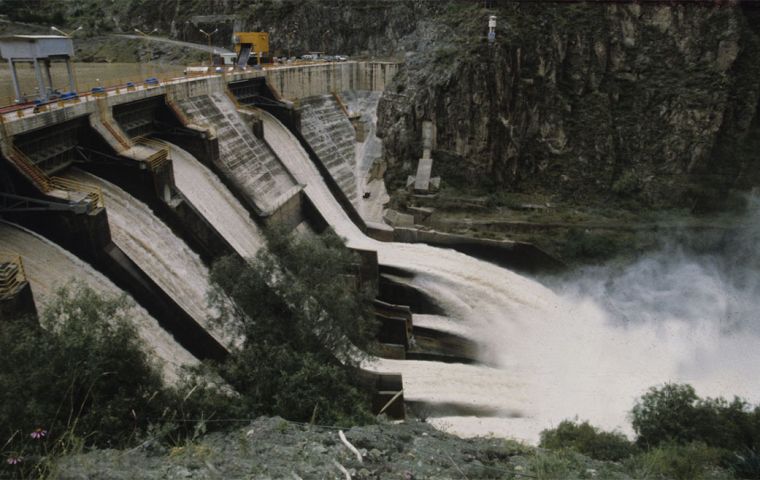MercoPress. South Atlantic News Agency
Brazil threatened by shortages in electricity supply due to water emergency
 The curent conditions are the result of a low volume of rainfall in recent months.
The curent conditions are the result of a low volume of rainfall in recent months. Brazil's Electric Sector Monitoring Committee Thursday issued a “water risk” warning and the Federal Government undertook a series of measures to avoid energy rationing until October, a period of low rainfall and more severe drought in the southeast and midwest, it was announced.
The alarm came after the National Meteorological Service issued a water emergency alert until September for the Paraná basin, which affects the Southeast and Midwest regions. Under the new state of things, the National Water Agency (ANA) is to determine, in the coming days, the reduction in the flow of hydroelectric reservoirs.
The current conditions are the result of a low volume of rainfall in recent months. According to data from the National Electricity System Operator (ONS), the volume of rainfall was even less than normal for May - and is expected to worsen in the coming months.
According to industry experts, there is a real risk of cuts in the supply of energy between September and October, since the rains should only normalize from November.
With the prospect of less rain and even more severe drought in the Midwest and Southeast regions of the country, the government created a crisis committee to address the issue. At the committee meeting this Thursday, government officials stated that measures to rationalize energy consumption should already be underway. Among them, resume the red flag on consumers' electricity bill.
The measure collides with the political spheres of the government, which fear its effect on inflation, which is already putting pressure on the lower-income population. On the other hand, the risk of rationing occurring in the second half of the year is increasingly high.
An immediate effect of reducing the flow of reservoirs in the country would be the unfeasibility of routes such as the Tietê-Paraná waterway, which currently transports a large part of the country's grain production.
With a low level of reservoirs, the National Electric Energy Agency (Aneel) has decided that the electricity bill will be more expensive in June.
Reservoir levels of the main hydroelectric plants are the lowest since 2015 and require greater use of thermoelectric plants, making electricity bills more expensive. Electricity bills of all consumers in the country will be charged an additional amount of R $ 6.24 for every 100 kWh of energy consumed.
It is the first time this year that the agency has activated the red flag level 2. During May, red flag 1 was in force, which applies an additional charge of R $ 4.16 for each 100 kWh consumed.
This measure reflects the low level of water storage in hydroelectric reservoirs in the Southeast and Midwest, which account for more than half of the country's generation capacity. According to the government, the last period of intense rain in the two regions, from November 2020 to April 2021, was the driest in 91 years.
When the level of the reservoirs is low, the government activates more thermoelectric plants, which generate energy from the burning of fuels, such as coal and diesel.
By activating more thermoelectric plants, the government reduces hydroelectric generation and saves water from reservoirs. However, the energy produced by thermal plants is more polluting and expensive, which is reflected in an increase in electricity bills.
The additional charging of the rate flag, created in 2015, serves precisely to raise funds that will pay for the higher cost of energy production.
Meanwhile, President Jair Bolsonaro has issued a decree regulating the hiring of “backup” plants to guarantee the supply of energy in critical periods.
As per the new decree, the government will be able to hold auctions to contract “capacity reserve in the form of power.” This means that new plants will be kept as a backup system to be activated if necessary to avoid the risk of blackouts.
“Eventual fluctuations in demand due to some increase in consumption or due to fluctuations in supply due to reduced generation at other plants can be supplied without interruption in the provision of electricity supply services. Ultimately, contracting this reserve of capacity makes the system more secure and stable,” the General Secretariat of the Presidency said in a note.
According to the General Secretariat, the Ministry of Mines and Energy will define the amount of energy to be bought or from which type of source, but since wind, solar and hydroelectric plants are subject to natural fluctuations they are not as reliable to guarantee a proper energy supply, which is why despite being more expensive, thermoelectric plants are to be preferred.




Top Comments
Disclaimer & comment rulesCommenting for this story is now closed.
If you have a Facebook account, become a fan and comment on our Facebook Page!